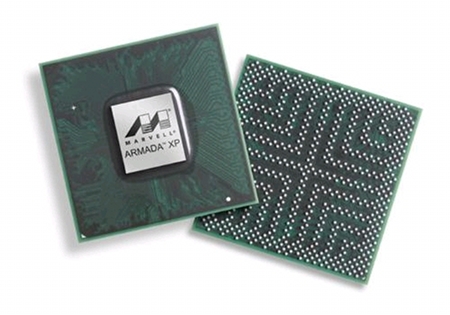Marvell spins quad-core ARM SoC for servers
Nov 9, 2010 — by LinuxDevices Staff — from the LinuxDevices Archive — 8 viewsMarvell says it is now sampling a quad-core, ARM-based processor aimed at “enterprise class cloud computing.” The Armada XP runs at 1.6Hz, has a 2MB second-level cache, supports 64-bit DDR3 memory, includes four gigabit Ethernet ports and other interfaces, and uses fewer than ten Watts, according to the company.
According to an August report, Facebook may be employing ARM-based servers in an upcoming data center it's building in Oregon. Meanwhile, an Austin, Texas-based company called Smooth-Stone is touting "data center performance with cell phone power," and says it is working to create ARM-based server CPUs.
For all that, Marvell's new XP — which is said to be sampling already, as well as on show at this week's 2010 ARM Technology Conference in Santa Clara — appears to be the first serious contender in the ARM server market. According to the company, it's "the fastest ARM processor available on the market today for enterprise-class applications, … optimized to consume strikingly low power."

Marvell Armada XP
As is its wont, Marvell released relatively few technical details, and no block diagram, in conjunction with its announcement. However, the Armada XP (above) is said to use four Marvell-designed ARM v7 processor cores clocked at 1.6GHz.
According to Marvell, the SoC (system on chip) is software-compatible with its existing Armada processors, which include the Armada 100, 500, 600, and 1000 families that were announced in October 2009. As such, it will presumably support Linux, Android, Windows Mobile, and Windows CE, though we're willing to concede that of these, Linux is likely the only serious candidate for server duty.
 Another relative is the Armada 300, a single-core, 2.0GHz device that was touted as "the industry's most powerful processor for applications utilizing the ARM instruction set" when it was announced last year. That SoC has been at the heart of the popular, Linux-based Plug Computer 3.0 (right), aimed at home media server and NAS (network attached storage) devices.
Another relative is the Armada 300, a single-core, 2.0GHz device that was touted as "the industry's most powerful processor for applications utilizing the ARM instruction set" when it was announced last year. That SoC has been at the heart of the popular, Linux-based Plug Computer 3.0 (right), aimed at home media server and NAS (network attached storage) devices.
According to Marvell, the Armada XP offers up to five times the performance per Watt of an equivalent (but unspecified) server chip from Intel. Using fewer than 10 Watts, it delivers a total of 16,600 Dhrystone MIPS, offering both heterogeneous multiprocessing and hardware-based cache coherence, the company says.
The amount of L1 instruction and data cache per core was not revealed, but there's 2MB of shared L2 cache, says Marvell. Meanwhile, it's said, the Armada XP's memory interface has ECC support and works with 64-bit DDR2, DDR3, or DDR3L memory running at up to 800MHz.
Marvell says the Armada XP has "multiple" USB ports, four PCI Express 2.0 lanes, and four "enterprise-class" gigabit Ethernet ports. Also highlighted are up to 16 high-speed SERDES (serial/deserializer) lanes, which can offer PCI Express, SATA, SGMII (serial gigabit media independent), or QSGMII (quad serial gigabit media independent) functionality, according to the company.
Marvell adds that it will offer "complete development platforms" for the Armada XP, including software drivers and a board support package (BSP). These will "enable developers to start system development without waiting for hardware," according to the company.
Weili Dai, co-founder of Marvell, stated, "Marvell's introduction of a powerful solution for enterprise-class cloud computing applications is a very important milestone in the mobile Internet revolution. Cloud computing mobile servers like those powered by the Armada XP are the key link in what I envision to be a seamless, unified ecosystem of mobile connected devices, information appliances and smart 'furnishings.'"
According to ARM Holdings, its next-generation Cortex-A series processor core, code-named "Eagle", will gain the ability to address more than 4GB of RAM, include hypervisor extensions, and transition to Global Foundries' 28nm production process. Marvell's Armada XP — a 40nm part, according to an item in The Register — does not offer these advantages, but should be able to compete with Intel's Atom, at the very least.
Further information
Marvell says its Armada XP is sampling now, and will be on display at the ARM Technology Conference at booth 200 until Nov. 11. No product page for the device had appeared at the time of writing, but information on existing Armada SoCs may be found here.
This article was originally published on LinuxDevices.com and has been donated to the open source community by QuinStreet Inc. Please visit LinuxToday.com for up-to-date news and articles about Linux and open source.